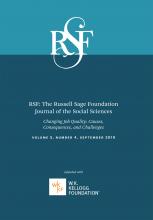Research Article
Open Access
Nonstandard Work and the Job Search Process: Application Pools, Search Methods, and Perceived Job Quality
David S. Pedulla, Katariina Mueller-Gastell
RSF: The Russell Sage Foundation Journal of the Social Sciences September 2019, 5 (4) 130-158; DOI: https://doi.org/10.7758/RSF.2019.5.4.05
David S. Pedulla
aAssistant professor in the Department of Sociology at Stanford University
Katariina Mueller-Gastell
bA PhD candidate in the Department of Sociology at Stanford University

REFERENCES
- ↵
- Addison, John T.,
- Chad Cotti, and
- Christopher J. Surfield
- ↵
- ↵
- American Staffing Association (ASA)
- ↵
- Autor, David
- ↵
- Autor, David, and
- Susan Houseman
- ↵
- Bernhardt, Annette
- ↵
- Bertrand, Marianne, and
- Sendhil Mullainathan
- ↵
- Broschak, Joseph P.,
- Alison Davis-Blake, and
- Emily S. Block
- ↵
- Browne, Irene, and
- Joya Misra
- Bureau of Labor Statistics
- ↵
- Bureau of Labor Statistics
- ↵
- Bureau of Labor Statistics
- ↵
- Bureau of Labor Statistics
- ↵
- Bureau of Labor Statistics
- ↵
- Bureau of Labor Statistics
- ↵
- ↵
- Clawson, Dan, and
- Mary Ann Clawson
- ↵
- Corcoran, Mary,
- Linda Datcher, and
- Greg Duncan
- ↵
- Dunn, Megan
- ↵
- Epstein, Cynthia Fuchs,
- Carroll Seron,
- Bonnie Oglensky, and
- Robert Sauté
- ↵
- ↵
- ↵
- Goldin, Claudia, and
- Joshua Mitchell
- ↵
- ↵
- ↵
- Henson, Kevin Daniel
- ↵
- ↵
- Hyman, Louis
- ↵
- Kalleberg, Arne L
- ↵
- Kalleberg, Arne L
- ↵
- Kalleberg, Arne L
- ↵
- Kalleberg, Arne L.,
- Barbara F. Reskin, and
- Kenneth Hudson
- ↵
- Kalleberg, Arne L.,
- Jeremy Reynolds, and
- Peter V. Marsden
- ↵
- Katz, Lawrence F., and
- Alan B. Krueger
- ↵
- Kim, ChangHwan, and
- Arthur Sakamoto
- ↵
- ↵
- Knowledge Networks
- ↵
- Krueger, Alan B., and
- Andreas I. Mueller
- ↵
- Marin, Alexandra
- ↵
- Mouw, Ted
- ↵
- Pager, Devah,
- Bruce Western, and
- Bart Bonikowski
- ↵
- Pedulla, David S
- ↵
- ↵
- Pedulla, David S
- ↵
- Pedulla, David S., and
- Devah Pager
- ↵
- Rivera, Lauren A
- ↵
- Rogers, Jackie Krasas
- ↵
- Sharone, Ofer
- ↵
- ↵
- Smith, Vicki
- ↵
- ↵
- Tilly, Chris
- ↵
- Tilly, Chris
- ↵
- Trimble, Lindsey B., and
- Julie A. Kmec
- ↵
- Virtanen, Marianna,
- Mika Kivimäki,
- Matti Joensuu,
- Pekka Virtanen,
- Marko Elovainio, and
- Jussi Vahtera
- ↵
- ↵
- Yakubovich, Valery
In this issue
Nonstandard Work and the Job Search Process: Application Pools, Search Methods, and Perceived Job Quality
David S. Pedulla, Katariina Mueller-Gastell
RSF: The Russell Sage Foundation Journal of the Social Sciences Sep 2019, 5 (4) 130-158; DOI: 10.7758/RSF.2019.5.4.05
Jump to section
Related Articles
- No related articles found.
Cited By...
- No citing articles found.





